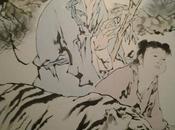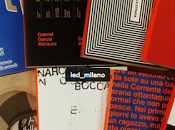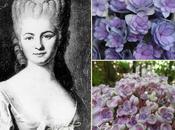Il segreto consisteva nel sapere che la sua vera natura viveva, perfetta come un numero non scritto, contemporaneamente dappertutto, nello spazio e nel tempo.
"Il gabbiano Jonathan Livingston" , Richard Bach

Lo yacht imperiale Miramar
Spira sovente, nei mattini di primavera, una brezza fresca che proviene dall'alto dei colli che fanno da schiera al golfo della capoluogo ligure, Genova, punteggiato di antiche fortezze, per giungere a lambire alcuni punti della città in cui le vie principali convergono ....
Piazza Acquaverde su cui si apre la Stazione di Porta Principe


è uno di quei luoghi della città che da sempre gode di questo frizzante alito mattutino che vi fa ritorno verso la fine della giornata, quasi come se volesse riedere da dove è provenuto, e certamente Lady Parker, appena scesa dal treno su cui era salita a Milano alcune ore prima, "in un compartimento riserbato della vettura di prima classe recante il N. 814"1 avrà pensato che pur approdando in una città di mare, avesse portato con sé parte di quel vento che scende giù dai suoi monti, anzi, forse avrà pensato che le ali di quello stesso Zefiro l'avessero seguita fin lì ...
... Ella aveva finalmente raggiunto una città di mare .... il mare, quel mare da lei tanto amato, di cui avvertiva il richiamo e a cui si sentiva tanto simile e legata nel profondo ... come il mare era mutevole, incostante, raminga, in cerca sempre di nuovi lidi su cui approdare ... anonima ... ineffabile ... infinita ...
Una carrozza la stava attendendo ( su di essa sarebbero saliti l'Imperatrice, la sua dama di compagnia, contessa Maria Festetics, il suo lettore di greco subentrato a Costantin Christomanos, professor Barker ) ed un altra era pronta per ricevere il suo breve seguito,
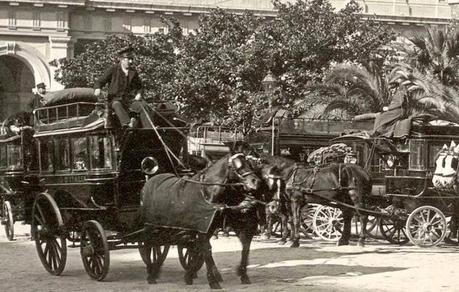 nessuno si era avveduto del suo arrivo, a quell'ora di tardo pomeriggio non vi era molto passaggio nella zona alta della città ... alla fine della giornata, come all'inizio del mattino, sono più animate le vie della città vecchia, quelle più vicino al porto,
nessuno si era avveduto del suo arrivo, a quell'ora di tardo pomeriggio non vi era molto passaggio nella zona alta della città ... alla fine della giornata, come all'inizio del mattino, sono più animate le vie della città vecchia, quelle più vicino al porto, 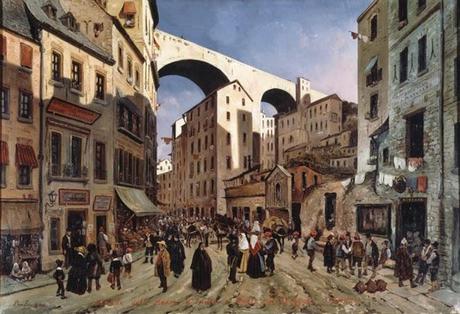
Strada della Madre d'Iddio e Ponte di Carignan a Genova, Pieter Van Loon (1801 - 1873)spesso luogo di mercati di fiori o di frutta e verdura proveniente dagli orti delle colline della valle del Bisagno ( ancor oggi in dialetto genovese le venditrici di frutta e verdura sono dette ' besagnine' ) gremite di gente dai volti e dalle parlate differenti.
Genova è una città difficile da comprendere - così eterogenea morfologicamente, culturalmente, storicamente - ... tanto facile da amare.
Due i cocchieri che la stavano attendendo seduti a cassetta: al vedere la sua nobile figura, fasciata in abito da lutto che la forgiava come un raro cigno nero - affiancata da un'altra dama, anch'ella vestita in abito scuro - uno scese dal proprio sedile per aprirle con riverenza la porta del veicolo che avrebbe dovuto condurla al Miramar, il panfilo imperiale attraccato nel porto, presso il Molo Giano ... Lady Parker era il nome con cui si presentava, la Storia ce l'ha 'consegnata' con il nome di Elisabetta d'Austria, l'Imperatrice.
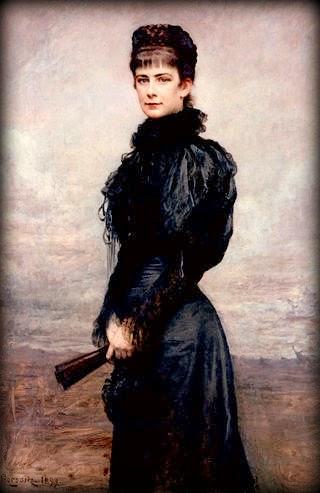
Elisabetta d'Austria in un ritratto di Leopold Horowitz, 1899
Il soggiorno genovese dell'Imperatrice, fermatasi nel capoluogo ligure per cinque giorni durante la Settimana Santa del 1893, da domenica 26 marzo al Venerdì Santo 31 marzo, rappresentano una delle tappe di un suo viaggio che era partito dal 'Lombardo Veneto', del quale non era ormai più regina ( Il Regno del Lombardo-Veneto, istituito con il Congresso di Vienna nel 1815 ed annesso all'Impero di Austria-Ungheria perse la Lombardia al termine della Seconda Guerra di Indipendenza nel 1859 per dissolversi poi definitivamente nel 1866, al termine della Terza Guerra di Indipendenza, quando il Veneto venne ceduto al Regno d'Italia con il trattato di Praga ), compiuto da semplice turista e proprio in qualità di turista scese a Genova per poi proseguire verso Napoli e raggiungere infine Corfù dove l'attendeva il suo solenne Achilleion, il sontuoso palazzo in stile neoclassico fatto edificare quasi fosse un Inno al suo eroe, Achille, tra il 1890 ed il 1891, un anno dopo la tragica perdita del figlio, il Principe Ereditario Rudolf, nella tragedia di Mayerling (1889).
Il Secolo XIX non si fece sfuggire l'occasione di seguire passo passo, per tramite di un suo cronista, ogni giornata dell'Augusta Signora, che non poteva passare inosservata data l'imponenza della sua figura, a chiunque la vedesse saltava agli occhi che si trattava di una persona di alto rango ..., ma ella si era spogliata della sua storicità, Genova non vedeva in lei l'Imperatrice, i genovesi l'ammiravano passandole accanto perchè non si amalgamava alla folla, anzi, ne emergeva in virtù dell'anonimato del suo essere più profondo ... ontologicamente Elisabetta d'Austria era 'non presente', con sé recava solamente l'istanza pulsionale, per dirla utilizzando termini cari a Freud, la muovevano il suo amore per l'arte, il bisogno di dialogare con le acque del mare, la smania di compiere lunghe passeggiate, l'attrazione per il mistero della morte ... L'Imperatrice era "davvero la qui assente: ecco la traduzione postmoderna del «più completo incognito» del 1893" 2 .
Ma osserviamola durante la sua prima giornata trascorsa nella Superba, accompagnata dall'aria che profuma di primavera e di mare, leggendo le annotazioni del reporter del giornale cittadino:
"S.M. vestiva di tibet nero, con una cintura di seta pure nera.
Aveva in testa un cappello nero; recava in mano un ventaglio di legno teak, ed un en-tout-cas bianco, foderato d'azzurro. Calzava stivalini fortissimi alla touriste.
La sua guida, aveva a tracolla una fiaschetta ed una borsa.
Il professore di greco vestiva accuratamente di nero.
La dama di compagnia vestiva in seta, con una capote in velluto e mantellina di pelo di martora.
L'Imperatrice camminava con passo svelto e sicuro.
La sua persona sottile e slanciata, destava l'ammirazione dei passanti, i quali pur non conoscendola, la giudicavano senza errore, per una persona d'alto grado.
Uscita dalla chiesa dell'Annunziata, S.M. si diresse per Corso Carbonara, ove fece una sosta nello studio dello scultore Domenico Carli, del quale esaminò parecchi monumenti quasi ultimati.
Uscita di là, rimandò la sua dama di compagnia, ordinandole di scendere in piazza Annunziata, di noleggiare una vettura e di recarsi ad attenderla a Staglieno." 3
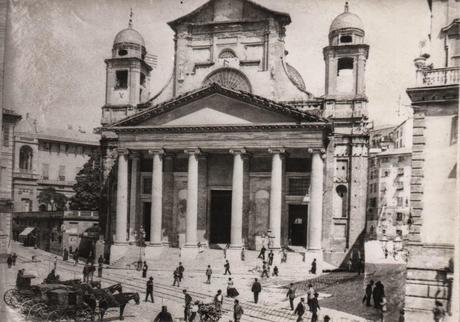
Piazza e Chiesa dell'Annunziata
Un percorso di più chilometri, a tratti impervio anche se decisamente panoramico, costituito spesso di aspre salite o 'rocche'
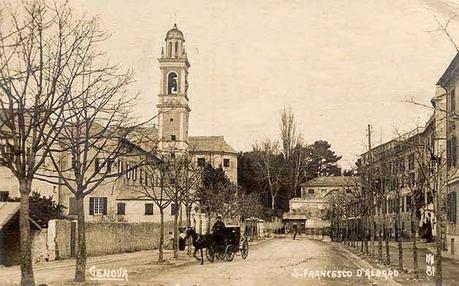
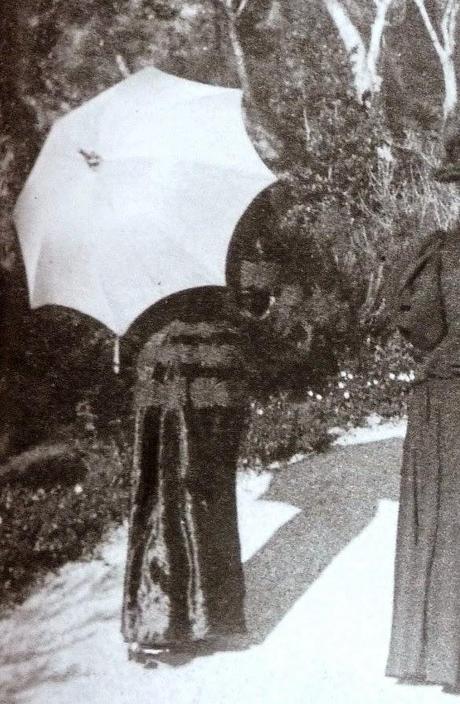
L'Imperatrice a passeggio negli anni '90
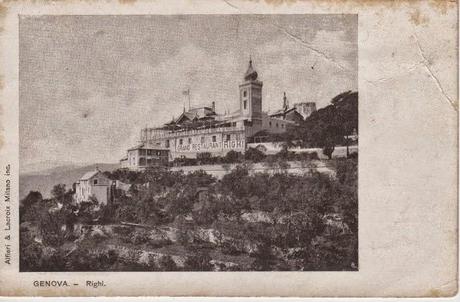
separa il centro della città dal Cimitero Monumentale di Staglieno dove a guardia di antiche tombe di famiglie nobili e patrizie cui Genova diede i natali o albergo vi sono poste allegorie della Pietà, della Misericordia, della Fede, riproduzioni di parenti rimasti in vita e tristemente privati dei loro cari, Angeli Guardiani e Protettori, tutti scolpiti nel marmo da sapienti mani d'artista ...
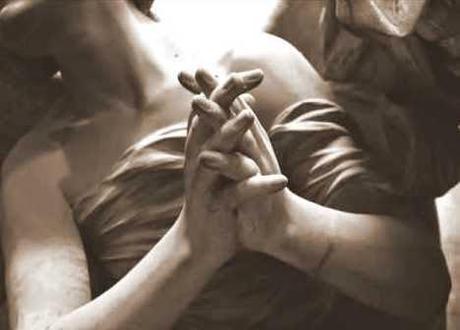
chissà che in questo museo all'aperto la cui fama aveva già allora varcato i confini dell'Italia, già visitato tra gli altri anche da Nietzche ed Oscar Wilde, non cercasse ispirazione per un monumento funebre da dedicare al suo Rudolf ... o forse più semplicemente cercava un dialogo con l'arcana oscurità che connota la fine della vita terrena.
"Dinanzi al monumento a Giacomo Carpaneto raffigurante una barca con un angelo, pregevole opera dello Scanzi, si fermò parecchio, e fece copiare suòl suo taccuino l'epigrafe: Avventurato chi nel mare della vita ebbe nocchiero sì fido."4
Chi soffre di anoressia non solo dà esibizione di una energia straordinaria, ma si pone di continuo nuovi limiti da superare, come se quasi in ciò cercasse compensazione al dolore che gli deriva dalla punizione che, inconsapevolmente, si autoinfligge privandosi del cibo; perciò anche in questo l'Imperatrice non manca di stupire il cronista de Il Secolo XIX quando con energia e velocità a Sestri Ponente sale il Monte Gazzo, alto 450 mt. sul livello del mare, per ammirare il panorama, dopo avere già visitato ed ammirato quello stesso giorno la Villa Pallavicini a Pegli ed il suo splendido parco pervaso da nostalgici echi neoclassici
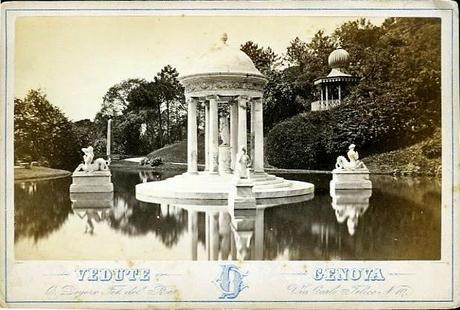
Villa Pallavicini, il Tempio di Diana in una fotografia del 1890
dai quali si sarà sicuramente lasciata affascinare in nome della sua totale dedizione per l'arte classica, che, con la sua sublime linearità, manifesta l'espressione dell'ideale di perfezione e di bellezza, attingendo inoltre al suo mondo mitologico e comunicando il carisma di un'epoca che non è più e che solo, compiutamente, nelle opere d'arte è in grado di rivivere.
Ed ancora non si lasciò sfuggire i lussureggianti giardini della Villa Groppallo di Genova Nervi
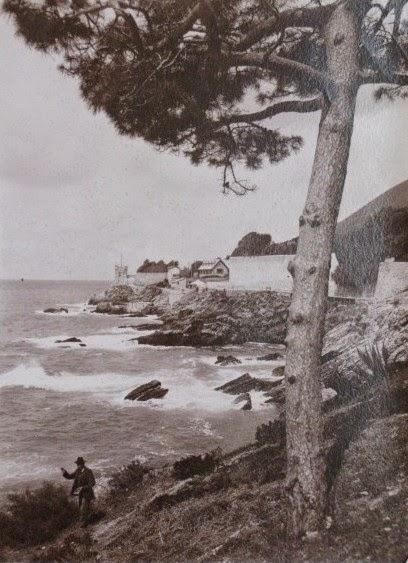
Nervi, passeggiata con marina e torre della Villa Groppallo sullo sfondo, ed. Alinari
che per un tratto corre lungo la passeggiata a mare raccogliendone gli echi ed il respiro salmastro ed infine le più antiche botteghe del centro storico genovese già rinomate per la produzione artigianale ed artistica di dolciumi e cioccolato quali la Confetteria d'arte della vedova Romanengo in Piazza di Soziglia
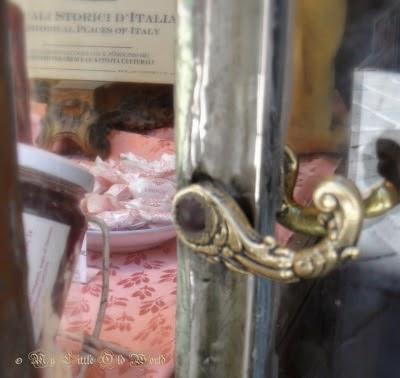
Mi piace concludere questo mio scritto citando le parole di Massimo Sannelli, giovane e già celebre scrittore ligure, a cui lo dedico per intero poichè con il libro "Una rapida ebbrezza - I giorni genovesi di Elisabetta d'Austria", da lui curato insieme con Vittorio Laura,
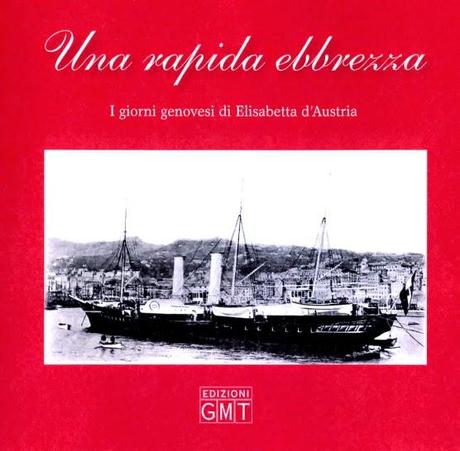
ne ha rappresentato la fonte d'ispirazione:
"A Genova si può vedere l’apertura totale dello spazio, tra cielo, mare e montagna. Nietzsche ci si è esaltato come Dioniso: «Rendo grazie alla mia sorte che mi ha fatto capitare in quella dura, austera città durante gli anni della décadence: e quando uno va a Genova è ogni volta come se fosse riuscito a evadere da sé: la volontà si dilata, non si ha più il coraggio di esser vili» (lettera a Peter Gast, 7 aprile 1888). L’aforisma 291 del libro IV della Gaia scienza è un inno: il genovese ha sempre cercato di «interporre tra sé e il suo vicino la sua personale infinitudine», «ad ogni angolo della strada, trovi un uomo che sta per conto proprio, che conosce il mare, l’avventura e l’Oriente, un uomo che è avverso alla legge e al vicino, come a qualcosa di tedioso…». Queste parole si possono applicare anche ad Elisabetta, né più né meno. "5
Ancora grazie a questo giovane talento dall'animo gentile a cui mi lega la mia formazione presso l'Università degli Studi di Genova ed i nomi celebri di coloro che la hanno promossa nonché il profondo trasporto per questo affascinante e delizioso personaggio che ha segnato la storia del XIX secolo.
Un saluto affettuoso a tutti i miei carissimi ed affezionati amici e lettori.
A presto ♥


Bibliografia:
Hellmut Andics, Die Frauen der Habsburger, WILHELM HEYNE VERLAG, München, 1995
Elisabetta d'Austria, Diario poetico, MGS PRESS SAS, 1998
ELISABETTA D'AUSTRIA NEI FOGLI DI DIARIO DI COSTANTIN CHRISTOMANOS, Adelphi edizioni S.p.A., Milano, 1989
Brigitte Hamann, Elisabeth. Kaiserin wieder Willen, Amalthea Verlag, Wien, München, 1982
Gabriele Praschl-Bichler, L'IMPERATRICE ELISABETTA, Longanesi & C. Editore, 1997Una rapida ebbrezza - I giorni genovesi di Elisabetta d'Austria, a cura di Vittorio Laura e Massimo Sannelli, EDIZIONI GMT, Genova, 2012 ( questo testo lo potete trovare cliccando qui )
Citazioni:
1 - Una rapida ebbrezza - I giorni genovesi di Elisabetta d'Austria, op. cit., pag 35
2 - Ibid. pag. 16
3 - Ibid. pag. 41
4 - Ibid. pag. 45
5 - Ibid. pag. 20

The Genoese days of the Empress Elisabeth of Austria.
The secret was to know that her true nature lived, as perfect as an unwritten number, everywhere, in the same time, in space and in time.
"The Seagull Jonathan Livingston", Richard Bach
- picture 1 - The imperial yachtMiramar
It often blows slight, in the mornings of spring, a cool breeze that comes down from the hills that make up the array to the Gulf of the Ligurian chief town, Genoa, dotted with ancient forts, leading to lick some parts of the city in which the principal streets converge. ...
Piazza Acquaverde, which opens into the station of Porta Principe
- picture 2 and picture 3 - Vintage postcards depicting Piazza Acquaverde and the Porta Principe Station
is one of those places in the city where always this crisp morning breath and where it makes return, at the end of the day, almost as if it wanted to come back from where it was born, and certainly Lady Parker, just got off the train on which she got on in Milan a few hours before, " in one private compartment of the first-class car bearing the N. 814" 1 would have thought that, despite arriving in a seaside town, she brought with her some of that wind that comes down from her mountains, indeed, maybe have thought that the wings of that same Zephyr had followed her there ...
Finally she had reached a seaside town .... the sea, the sea she loved so much, of which she felt the call and to which she felt so similar and linked in her deep ... so as the sea she was changeable, inconstant , wandering, always in search of new shores on which to land ... anonymous ... unspeakable ... endless ...
A carriage was waiting for her at (on it would go up the Empress, her lady-in-waiting, Countess Maria Festetics, her greek reader that replaced Constantin Christomanos, Professor Barker) and another was ready to receive her brief following,
- picture 4 - A vintage coachman leaving the Station
no one was aware of her arrival, at that hour of the late afternoon there wasn't a lot of transition in the upper area of the city ... at the end of the day, as early in the morning, are much more lively the streets of the old city, those nearest to the port,
- picture 5 - Strada della Madre d'Iddio e Ponte di Carignan a Genova, Pieter Van Loon (1801 - 1873)
often place of markets of flowers or fruit and vegetables coming from the fields of the Val Bisagno (still nowadays in Genoese dialect, the sellers of fruits and vegetables are known as 'besagnine') filled with people whose faces and speaks are so much various.
Genoa is a city hard to understand - so different morphologically, culturally, historically - ... so easy to love.
Two were the coachmen who were waiting for her and as soon as saw her noble figure, swathed in a mourning dress that forged her as a rare black swan - accompanied by another lady, also dressed in a dark suit - one came down from his seat to open, with reverence, the door of the carriage that should have led her to the Miramar, the imperial yacht moored in the harbor, at the Molo Giano ... Lady Parker was the name with which she introduced herself, History has 'handed her over' to us with the name of Elizabeth of Austria, the Empress.
- picture 6 - Elisabeth of Austria in a portrait by Leopold Horowitz, 1899
The Genoes stay of the Empress, lasted five days during the Holy Week in 1893, from Sunday March 26 to Friday March 31, represent one of the stages of a journey that had started from the 'Lombardo Veneto', of which she wasn't queen anymore ( the Kingdom of Lombardo-Veneto, established by the Congress of Vienna in 1815 and annexed to the Empire of Austria-Hungary, lost the Lombardia at the end of the Second War of Independence in 1859 to dissolve then finally in 1866, at the end of the Third War of Independence, when the Veneto was ceded to the Kingdom of Italy with the Treaty of Prague), made as simple tourist and just as a tourist she arrived to Genoa for went on her way to Naples and finally reach Corfu where her solemn Achilleion, the sumptuous palace in neo-classical style made built almost like a hymn to her hero, Achilles, between 1890 and 1891, a year after the tragic loss of her son, Crown Prince Rudolf, in the tragedy of Mayerling (1889), awaited her.
IL SECOLO XIX didn't miss the chance to follow step by step, through a chronicler of its, every day of the August Lady, who could not pass unnoticed given the size of her figure, everyone saw it was clear she was a high ranking person ... but she was stripped of her historicity, Genoa didn't see her as the Empress, the Genoese admired her walking beside her because she didn't amalgamate with the crowd, indeed, she emerged because of the anonymity of her deepest inner ... ontologically Elisabeth of Austria was 'not present', with her she only brought the 'instinctual istance', to put it using terms dear to Freud, her love for art, her need to communicate with the waters of the sea, her desire to take long walks, her attraction to the mystery of death drove her... the Empress was "really here absent, here is the translation of the postmodern" more complete incognito "of the 1893" 2.
But let's have a look at her during her first day in the 'Superba', accompanied by the air smelling of spring and of sea, reading the records of the city newspaper reporter:
"S.M. dressed in black tibet, with a black silk belt as well.
She was wearing a black hat; she hand a fan of teak wood, and an en-tout-cas white, lined in blue. She wore very strong booties at the touriste.
Her guide had a flask and a shoulder bag.
The professor of greek dressed carefully in black.
Her lady-in-waiting was dressed in silk, with a velvet hood and cape sable.
The Empress walked briskly and safely.
Her slim and slender person, aroused the admiration of passersby, which, while not knowing her, they judged her without error, for a person of high rank.
Leaving the Church of the Annunziata, S.M. went to Corso Carbonara, where she made a stop in the studio of the sculptor Domenico Carli, where she examined several monuments of his almost completed.
Out there, she sent her lady-in-waiting and ordered her to reach the Piazza dell'Annunziata, rent a carriage and go to Staglieno waiting for her. "3
- picture 7 - Piazza and Chiesa dell'Annunziata
A walk of several miles, sometimes impassable even if panoramic, often consisting of rugged hills or 'rocche' (hard climbs)
- picture 8 - Vintage postcard from Genoa, S.Francesco d'Albaro
- picture 9 - The Empress having a walk in the 90's
- picture 10 - Vintage postcard from Genoa, Righi
separates the city center from the Monumental Cemetery of Staglieno where guarding ancient tombs of noble and patrician families to which Genoa gave birth or harboured are placed allegories of Ruth, Mercy, Faith, reproductions of surviving relatives sadly deprived of their loved ones, Guardian and Protector Angels, all carved in marble by skilled hands of artist ...
- picture 11- Detail of a monument in the Cemetery of Staglieno
I wonder if in this open-air museum, whose reputation had already crossed the borders of Italy, visited, among the others, by Nietzsche and Oscar Wilde, she was looking for such inspiration for a memorial to dedicate to her Rudolf ... or maybe, more simply, she sought a dialogue with the mysterious darkness that characterizes the end of our earthly life.
"In front of the monument to Giacomo Carpaneto depicting a boat with an angel, a valuable work of Scanzi, she stopped herself a lot, and made writein her notebook the inscription: Ventured who into the sea of life had such trusty helmsman."4
Those suffering from anorexia not only give performances of extraordinary energy, but arise constantly new limits to be overcome, almost as if they had to compensate the pain coming from the punishment they unwittingly inflict depriving themselves of food; so even in this the Empress never fails to impress the reporter of IL SECOLO XIX when with impressive energy and speed in Sestri Ponente she went on the Monte Gazzo, 450 meters high above sea level, to admire the view, after having already visited and admired the same day the Villa Pallavicini in Pegli and its beautiful park filled with nostalgic neoclassical echoes
- picture 12 - Villa Pallavicini, The Temple of Diana in una photograph dated 1890
from which she'll surely be left fascinate in the name of her total dedication to the classical art, which, with its sublime linearity manifests the expression of the ideal of perfection and beauty, also drawing on its mythological world and communicating the charisma of an era that is no more, and only, fully, in the works of art, is able to revive.
And she also didn't miss the lush gardens of Villa Groppallo in Genova Nervi
- picture 13 - Nervi, promenade and seaside with the tower of the Villa Groppallo on the background, Alinari editions.
that for a stretch runs along the promenade reaping the echoes and the salty breath of the sea and finally the oldest shops in the historical center of Genoa already renowned for the manifacturing production of confectionery and chocolate such as the Confectionery of art of the widow Romanengo in Piazza di Soziglia
- picture 14 - entrance door
(of which here I've already had the chance and the great pleasure to tell you about) before leaving on the morning of March 31st, plowing the waters of the Gulf, having as a destination, it is supposed, Portofino.
I would like to conclude my writing quoting the words of Massimo Sannelli, young and already famous Ligurian writer, to whom I dedicate it entirely as with the book "Una rapida ebbrezza - I giorni genovesi di Elisabetta d'Austria"which he edited together with Vittorio Laura,
- picture 15 - "Una rapida ebbrezza - I giorni genovesi di Elisabetta d'Austria",cover
has been my source of inspiration:
"In Genoa you can see the full opening of the space between sky, sea and mountains. Nietzsche exalted himself as Dionysus:" I give thanks to my fate that has made me come in that hard, austere city during the years of decadence : and when one is going to Genoa every time it's as if he had managed to escape from itself: the desire expands, you no longer have the courage to be vile "(letter to Peter Gast, April 7th, 1888). The aphorism 291 Book IV of The Gay Science is a hymn: the Genoese has always tried to "interpose between himself and his neighbor his own infinitude," "at every corner of the street, you find a man who is on his own, who knows the sea, the adventure and the East, a man who is against the law and his neighbour, as for something tedious... "These words can also be applied to Elizabeth, neither more nor less." 5
Thanks again to this young talent by the gentle soul which I'm linked by my training at the University of Genoa and the famous names of those who have promoted it and by the deep love for this charming and delightful character that has marked the history of the XIXth century.
An affectionate greeting to all my dearest and loyal friends and readers.
See you soon ♥


Bibliography:
Hellmut Andics, Die Frauen der Habsburger, WILHELM HEYNE VERLAG, München, 1995
Elisabetta d'Austria, Diario poetico, MGS PRESS SAS, 1998
ELISABETTA D'AUSTRIA NEI FOGLI DI DIARIO DI COSTANTIN CHRISTOMANOS, Adelphi edizioni S.p.A., Milano, 1989
Brigitte Hamann, Elisabeth. Kaiserin wieder Willen, Amalthea Verlag, Wien, München, 1982
Gabriele Praschl-Bichler, L'IMPERATRICE ELISABETTA, Longanesi & C. Editore, 1997Una rapida ebbrezza - I giorni genovesi di Elisabetta d'Austria, a cura di Vittorio Laura e Massimo Sannelli, EDIZIONI GMT, Genova, 2012 ( you may find this book here )
Quotations:
1 - Una rapida ebbrezza - I giorni genovesi di Elisabetta d'Austria, op. cit., page 35
2 - Ibid. page 16
3 - Ibid. page 41
4 - Ibid. page 45
5 - Ibid. page 20
